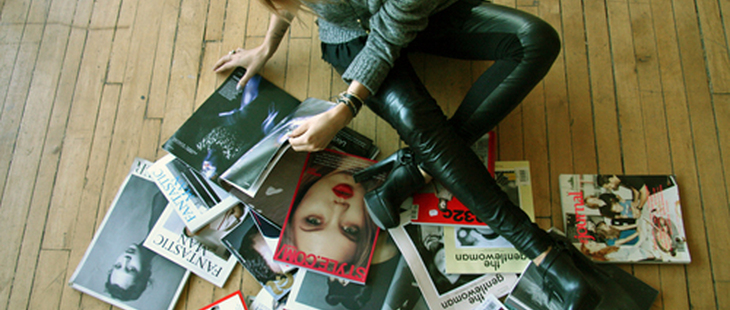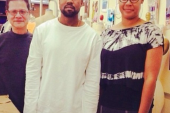
If Vogue is the Bible, Style.com—launched in September 2000 as the online companion of both it and W—is the study guide. Everybody who is in fashion, wants to be in fashion, or sometimes over a long lunch thinks “I wonder what is happening in fashion” uses it. In minutes you can find out when your new favourite designer debuted, whether Tim Blanks thought Givenchy Spring 2009 was any good, which shoe shapes dominate this fall, how many parties Mila Kunis attended last year, who the next top models are, how to get the perfect cat-eye the day after you spot it at Lanvin. If you want to see what fashion people are wearing at the shows, you look first and maybe only at Tommy Ton’s photos (he has his own URL, style.com/tommyton). When stylists pull “look #18” or “look #6” from a designer’s showroom, they’re getting the numbers from Style.com’s runway slideshows, which are put up within hours of each spring or fall or resort or pre-fall show in New York, in Milan, in London, in Paris.
It has influenced the way magazines do trend reports, facilitated perhaps 90% of all fashion blogs, and forced newspaper fashion critics to carry laptops to shows so they have a hope in hell of beating Style.com to the verdict.
No other fashion website is so reliable, assured, comprehensive, clean, easy to use. There are bazillions of those blogs, and many of them are very cool and good, but Style.com has no competitors. It has alternatives: the girl-next-door Refinery29, the insider-y but democratic Fashionista, the rapturous, celeb-obsessed Stylelist. But the audiences of those sites seem to skew younger, and their voices of the sites themselves are personal and bloggy/chatty and loud, often cancelling each other out. After 10 years, which is a lifetime on the internet, Style.com—which split from Vogue a year ago and is now run by Fairchild, a division of Conde Nast—remains the only authoritative resource.
So why, why, would they do something as frivolous, indulgent, and frankly unnecessary as launch a print magazine in 2011?
“We thought, what do we really well?” says Nicole Phelps, the executive editor of Style.com and second-in-command at the magazine (Dirk Stanton is editor-in-chief). “The collections. We wanted not only to synthesize them, but to show them backwards, forwards, sideways. We wanted to give readers better than a front-row seat.”
I don’t know about that—have you really lived until you’ve watched a Christopher Kane show from under the folds of your seatmate’s million-yard Alaa skirt, choking on perfume redolent with orchids and horse dung, overhearing snippy French-accented comments about any model weighing over the death limit? But what the Style.com team has done, effectively, is capture on the still page the frenetic, relentless pace of fashion week in four capitals. London, Milan, New York, Paris reads the spineline, and that’s what the magazine delivers, in true whirlwind fashion. It’s like one long “wish you were here” postcard. Or a time capsule. “I like that word, time capsule,” says Phelps. “The thing we’ve heard over and over again, from everybody we’ve talked to, is that they want to keep the magazine forever.”
Titled Style.com/Print, which is either very tongue-in-chic or totally lazy, or both, the biannual mag’s sole coverline is “Spring 2012.” While traditional fashion magazines are doing “holiday looks for less” and “lose weight by New Year’s!” and “the ultimate gift-giving guide,” the Style.com magazine is exclusively about… traditional fashion. Except, you see, at internet speed.
Three weeks after the last of the spring shows, they are all summarized and enshrined here, bound up in a delightfully low-res, exuberantly designed, slapdash scrapbook that manages to celebrate the authority of Style.com—lots of Top 10 lists, and an inside-baseball comparison of editor’s fave shows, i.e. Balenciaga, with those that got the most pageviews, i.e. Chanel—while being many things it’s not. There are, for example, more typefaces than a sixth-grade school project. It looks like it was designed as much by hand as by computer; the cover is the only minimal thing about it. The few longform articles, including a ten-year history of Proenza Schouler and a great interview with maestro Azzedine Alaa, are done in tiny tiny old-school text. There’s a 23-page editorial about one model—the blonde, 17-year-old, not-in-Kansas-anymore cover girl Lindsey Wixson—that seems destined for dreamy pink bedroom walls across America.
The magazine costs $14.99 (a bit much, perhaps) if you buy it on newsstands and $4.99 if you order it online (naturally, this is the fastest way to get it, especially if you live here in circulation-slow Canada). It’s further subsidized by fall ads selling fall clothes, which seems funny in a Spring ’12 publication, but really perfectly illustrates the essential ahead/behind binary of fashion. I wonder how said “traditional fashion magazines” will respond. This August, Flare put out a “special runway issue,” a trend report all about Fall 2011; it was quite well-done, looking a little like Vogue‘s or Elle‘s Collections magazines, a.k.a. the definitive guides to the season before, well, Style.com. Will Flare be doing a Spring ’12 trend report this time next year? It seems unlikely the rest of the publishing industry—least of all in Canada—will catch up quite so fast, or feel the motivation to do so. The Style.com/Print magazine is in some ways an industry rag, in some ways a fan’s guide, and certainly it’s for a highly fashion-conscious reader; its pace, design and purview would almost totally confuse the average Vogue or Elle or Flare or FASHION subscriber.
Page 2 of 2
But in fashion, for all its claims to art, almost everything—the whole two-season, then four-season system—is descended from the demands and advances of retail. Why is seemingly every designer and their diffusion line in New York, Paris, Etc., dragging editors out to see their “resort” collections? Who goes on “resorts?” But these more-commercial clothes are selling, often in greater quantities and/or at higher profit margins than the more-directional offerings of the traditional fall and spring seasons. And those traditional seasons were predicated on the time it took for clothes to be designed, shown, produced and shipped, back when things were sewn, not factory-stitched. The first pret-a-porter weeks in Paris weren’t set up, believe it or not, for amateur writers with opinions and cameras, but so that buyers from department stores could see everything in one place. The spirit of capitalism has always dictated the pace of fashion.
So now that you can buy Burberry coats seconds after their Spring ’12 show, or go to Style.com for “instant gets” from “next season” sold in partnership with Edition01, or order head-to-toe looks right off the runways via Moda Operandi or Canada’s own Peacock Parade, it seems suddenly very old-fashioned for magazines to be only a month ahead (now on stands, as you know, are the December issues) when they could be dated six months in the future. Of course, we will lose completely the pleasures of anticipation, of waiting to discover, of—that weird grandparental concept—saving to buy something. About that, what can we do? Not long ago I was talking to a stylist-friend, and he said he missed the days when he had to wait 24 or more hours to see a show on Style.com. How quick is our nostalgia now! I feel the same way, but know we wouldn’t choose to go back. Still it’s strange to look at this Style.com magazine, this print product which should seem old-fashioned but is instead weirdly modern-nostalgic, which is not reversing the speed its online entity helped bring to fashion, but is instead, somehow, accelerating it.
The more comforting thing to glean from the arrival of Style.com/Print is that print is not dead, especially not in fashion. It might just come after the slash. This has been a surprisingly great year for American Vogue, which despite being drastically out of touch (ooh, let’s get $300 real-snakeskin manicures!) has reported an 11% in newsstand sales (thanks mostly, admittedly, to that Lady Gaga cover). Meanwhile, they’re ramping up their own site. Some of the very best and most important fashion and art magazines out there, like 032c, The Gentlewoman, and Acne Paper began firmly as print products even in the internet age, but are now expanding their online presence. Others are beginning online, then moving to print; similarly, bloggers like The Selby and The Sartorialist have coffee table books and magazine columns. Why? Because The Devil Wears Prada wasn’t about Style.com. There is a glamour, a rarefied sense of validation and authority, that is crucial to fashion—moreso, I think, than to other forms of art/commerce—and that can never be reproduced online.
Here in Canada, The Kit, an online Toronto-based beauty and fashion site, has begun publishing a weekly glossy insert with the Toronto Star (its owners), the Montreal Gazette, the Calgary Herald and the Vancouver Sun. It’s a pretty logical step for a publication that, even online, looks like a magazine; then again, why spend all that money when they’ve got 2,000 new iPad users a day? Well, says publisher Doug Wallace, it’s no longer an either/or issue for publishers, but a question of how best to do both.
“The print product is the same and kind of different as our digital issue,” explains Wallace. “Tabloid size, glossy paper, the colour and richness of the visual experience is going to be richer, and juicier. I know I can’t really get the gleam in the eye of a model to look online the way it does in print, the way the retoucher does it for print.
“And of course, I like the feeling of having the printed product. Everybody likes the way a magazine smells. We want not only more readers, but different readers, for whom print will always be important and for whom, I guess, online isn’t as much part of their lives. And there’s lots of choice, for both readers and advertisers. Print and online stuff have to co-exist to prop each other up.”
The rise-again of print in fashion is something more romantic than that, though, and more obvious. Anyone who really loves clothes loves material, the swish, the feel. The tactility. Everyone I know who’s obsessed with fashion, no matter their age, is equally obsessed with magazines. You buy them, collect them, throw them out, trade them, cut them up, recycle them; in short, you treat them just like clothes. You can’t love one and not the other. And so what’s dead isn’t print, but the whole silly overwrought discussion of whether it’s dying. As long as we we are wearing real, moving garments made from some combination of fibres, we will be reading and poring over fashion, printed on same.
__
Sarah Nicole Prickett is the Toronto Standard Style Critic.















